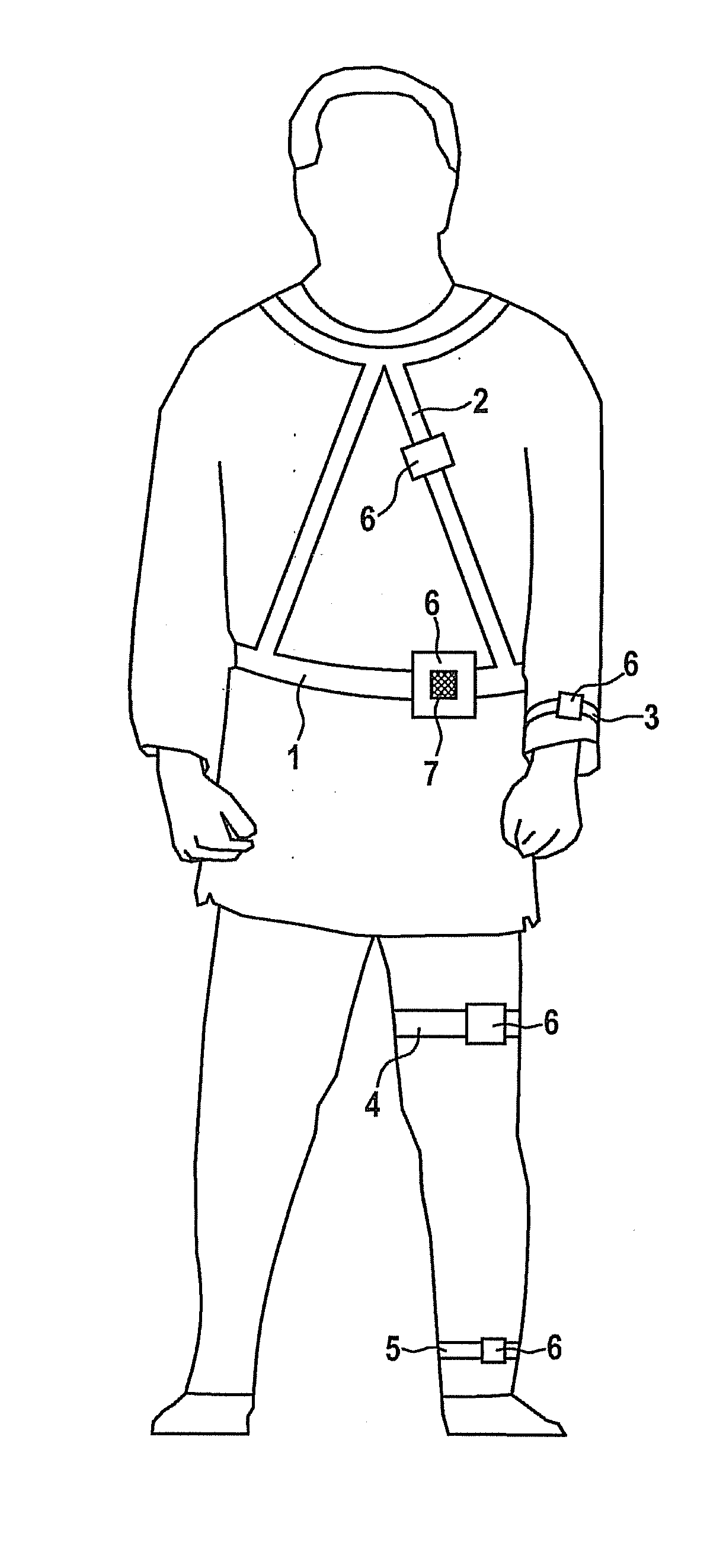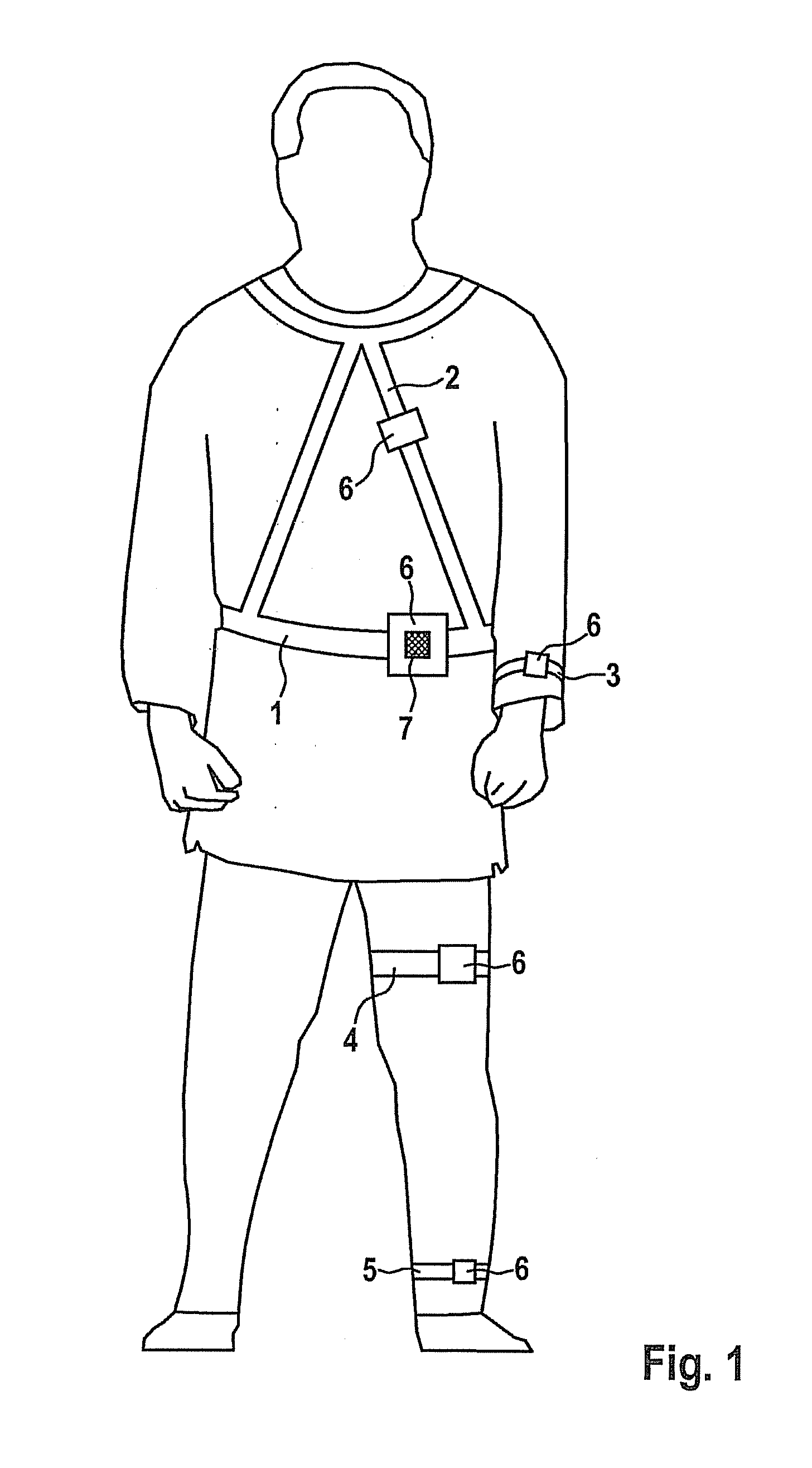[0010]In one particularly preferred specific embodiment of the movement sensor according to the present invention, an automatic change between various operating
modes is provided, the particular operating mode relating to different environmental conditions. The various operating
modes are preferably an operating mode for movements in the air and an operating mode for movements in water. This means that by changing over these operating modes, it is possible to differentiate between a movement in air and a movement in water, i.e., in particular swimming. The corresponding movement or acceleration signals are analyzed in accordance with a movement in air, i.e., in particular walking, standing, sitting,
lying down, etc., and a movement in water, i.e., in particular swimming. Exercises in water play a large role within the scope of
medical rehabilitation. For many patients, in particular also the chronically ill or older persons, a movement in water represents a very suitable form of movement in order to be physically active. The movement sensor according to the present invention is suitable in a particularly advantageous way for detecting the activity in the water and for taking the activity in water into consideration within the scope of a longer-term movement profile. In this case, the acceleration sensor may differentiate between different environmental conditions, i.e., in particular between air and water, so that the acceleration sensor may automatically select the particular suitable operating mode or accordingly change to the operating mode. Without a change of the operating mode from air to water, an activity during swimming would be incorrectly interpreted, for example, a backstroke would be interpreted as
lying down. It is therefore provided according to the present invention that a change into the water is detected by the movement sensor and thus another analysis and interpretation of the detected movement signals may take place. The particular
advantage of the present invention is that this
changeover takes place automatically, without the operator or user having to think about it. In this way, possible incorrect inputs during the operation of the sensor or the corresponding device are also prevented beforehand. A change between an activity in the water and an activity in the air is therefore detectable without intervention of the user, so that a very detailed movement log may be established in a simple way.
[0011]In one particularly preferred specific embodiment of the movement sensor according to the present invention, it is provided that an additional sensor for detecting the changing environmental conditions is assigned to the movement sensor. In particular, water may be differentiated from air by the additional sensor. For example, a sensor for detecting the
moisture, the temperature, the pressure, and / or the resistance is particularly preferably provided as the additional sensor. For example, a capacitive
moisture sensor may be used to detect the
moisture. If this sensor detects moisture of a specific or predefinable degree, it may be concluded that the sensor and therefore the person is located in water. Another option is a temperature sensor as an additional sensor. The
water temperature typically differs from the
air temperature, so that upon the detection of a sudden temperature change, it may be concluded that the person has changed from the air into the water. Typical water temperatures, as are to be encountered in the swimming
pool, for example, may be taken into consideration for this purpose, so that incorrect interpretations do not occur when the person changes from an interior to the outside, for example. Here also, a sudden temperature change may occur. Furthermore, a
pressure sensor may be used as an additional sensor, for example, since different pressure conditions prevail in the water than outside the water. Another option is the measurement of the resistance, in particular the transition resistance between two contacts, for example, between the contacts of a charging plug. The resistance between two contacts depends on the ambient medium, and therefore the transition resistance changes between two contacts when a change takes place between water and air. By monitoring the resistance, it may therefore be detected whether the movement sensor is in the water or in the air. The use of the resistance measurement between two contacts has the particular
advantage that such contacts are typically present in any case, in particular if the movement sensor is operated via batteries, so that no further components are necessary for the additional sensor for detecting air or water. If the movement sensor is operated via batteries, contacts are typically led outward in order to charge the battery. These contacts are generally monitored in that it is checked whether a charging current is present, for example. In this way it may be detected whether the movement sensor is in a
charging station. Only a slight modification of the sensor, e.g., an additional terminal on an A / D converter, is necessary to monitor the transition resistance between these contacts with respect to a detection of the environmental conditions. The following states may thus be detected on the basis of these contacts:
[0012]sensor in the
charging station (e.g., charging current present and additionally a “short-circuit” of the contacts through the
voltage source)
[0015]In this specific embodiment, it is possible without special effort, in addition to establishing the movement profile through the movement sensor, to establish whether the movement sensor is located in the water or in the air, so that the corresponding operating mode may be set automatically without user intervention.
 Login to View More
Login to View More  Login to View More
Login to View More 


